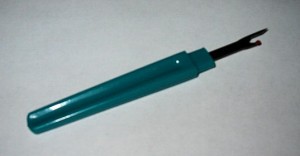Alterations are pretty straightforward most of the time. But when working with garments that have a lining, it gets a bit more complex.
When a garment – a jacket, for example – is fitted with a lining, it is assembled inside out. By placing the inner surfaces to the outside, the seam stitches will be hidden when the jacket or other garment is turned right side out again.
Do you see the problem? If the entire lining is attached to the shell, you can’t turn it right side out!
That’s where access points, also called entry points or closure points, come in. A section of the lining is left unstitched so that the garment can be reversed through the opening.
But that leaves an opening between the shell and the lining. And merely stitching that together leaves an unsightly seam as well.
Creating the original access point
When making new clothes, you need to create the access point stitching to hide the seam properly. Some garments may require more than one. To do this:
- While assembling the garment, choose a section of the lining where edges of the lining meet and do not sew it together.
- Turn the garment right side out through the opening.
- Fold over the raw edges of the lining and press with an iron to create smooth, clean edges. Make sure the material’s raw edge is turned toward the inside, between the lining and the outer shell.
- Match up the two edges and carefully sew them together using a tight stitch that is very close to the edge of the material.
- Congratulations! You’ve just created an access point!
Using the access points for alterations or repairs

Use the seam ripper to open the access point – carefully!
I often need to repair a torn cuff lining or shorten a sleeve on a jacket. This is when access points become very useful. To perform the repair or alteration:
- Search the garment’s lining for the nearest access point. They are often hidden inside sleeves or at the back and middle of the garment. There may be more than one access point.
- When you find it, carefully open the seam using a seam ripping tool. Work slowly and methodically to make sure you don’t tear a hole in the lining.
- Once opened, you then turn the garment inside out through the access point.
- Make the alteration or repair and then turn the garment right side out through the access point.
- Carefully close up the access point using the same sewing technique used when making it originally.
- You’re done! You’ve just made a great repair or alteration and no one will know how you did it!
By the way, you often need to use the access point when replacing a zipper on a lined jacket or coat. Access points are handy for all kinds of alterations and repairs. They can even be used when making pillows and other craft items.
Tip – Finding the access point takes practice . . . and patience!
A well-constructed access point is almost invisible. In fact, most people don’t even know that they exist!
The next time you take a trip to the clothing store, look at various types of lined garments while you’re shopping. Search over the linings for the access points. The seam will look a little different than the other seams in the garment.
Take note of where they are located to give you a starting point when searching for the access points on clothing you need to repair yourself.
And don’t forget to look at the jackets and such in your own closets! If your family is hard on clothing, particularly jackets and coats like my hubby is, you’ll want to find them easily.
Have “sew” great a day,
Mary Maurer – your personal, professional seamstress

Wonderful tips! I used to do alterations when my boys were little. I had to teach myself these “tricks” by reverse engineering every garment I worked on. Would have loved to have found you back then. But that was even before the days of the Internet 🙂 Your posts are short, to the point and very well written. Alteration is not always fun work but often challenging. A good seamstress is hard to find. I hope your clients appreciate you.
P.s. I also used to do creative sewing projects on the side. LOVE, LOVE, LOVE your doggie vests!
Thank you, Jody!
I’m so glad you enjoyed the tip.
Did you know you could make some extra money with the dog vests? Local animal shelters hold Adopt-A-Pet outings in our town square.
You might find some that need them in and around your hometown as well!
Have a “Sew” great day,
Mary
Thank You for the professional answer. I do free mending for elderly clients. This tip will save a well loved vest.
Hi, Tammy. I’m so glad that you found it helpful! Have a wonderful day. Mary
I have a wedding dress that is lined and is usually pretty simple to do it but for some reason when the bride put on the dress the it kept going moving to the side. Could it’s being that the lining is smaller than the outside fabric
I have a wedding dress that is lined and is usually pretty simple to do it but for some reason when the bride put on the dress the it kept going moving to the side. Could it’s mean that the lining is smaller than the outside fabric
I just found your article while googling how to remove a decorative half belt on the back of a vintage linen jacket. The belt is a contrasting color, with the ends sewn into the side seams. I inspected the acetate lining, trying to find the access point. It wasn’t easy, but I finally located a single access point inside one of the sleeves. I carefully removed the tiny stitches with a seam ripper so I could access each of the side seams and remove the offending belt.
I also considered removing the shoulder pads, as they are larger than I prefer to wear. They work with the structured jacket shape though, as it’s a military inspired style. Unless shoulder pads are very minimal, removal can be tricky as the cut of the garment was designed to accommodate them. I’m not sure that my skills are quite up to an alteration of that complexity.
Hi Mary,
I’m altering the shoulders of a blazer and I can’t get inside the lining as the lining is stitched round the arm hole to the outer fabric. How do I get inside this without having to take everything apart, or will i have to take it apart?
I have a wonderful leather jacket, but the lining was ruined (won’t go into that here). How can I go about creating a lining for the jacket?
Thank you,
Beth Ann